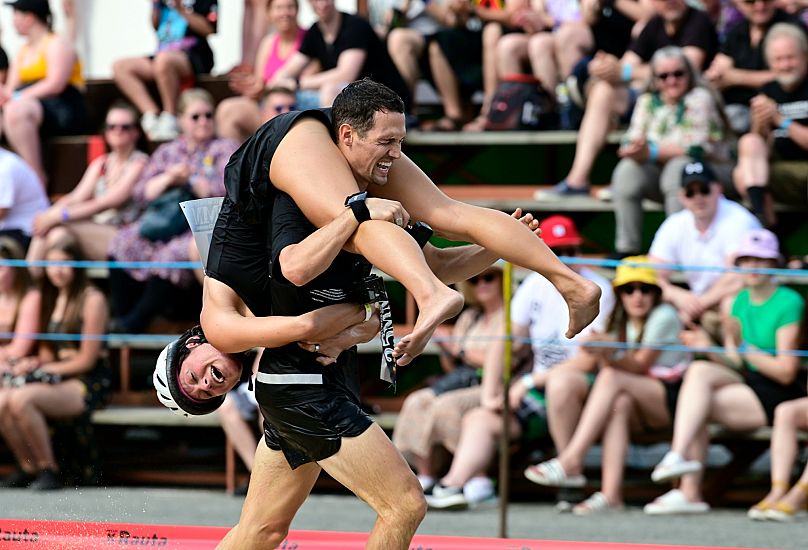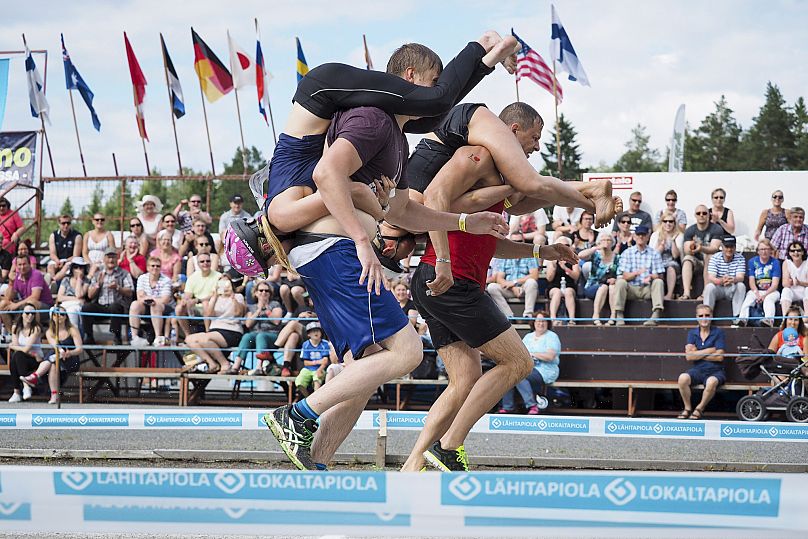The Wife-Carrying World Championship – known as Eukonkanto – starts today and runs until tomorrow in Sonkajärvi, in the Northern Savonia region of Finland.
Held since 1992, the annual sporting event involves male participants carrying their female partners on their backs through a challenging obstacle course, which features water, hurdles and sand pits.
Not just a test of physical strength and endurance, the championship centers around communication, mutual trust, and teamwork. And a love of brew too, as the winning couple don’t receive a medal or a cash prize but the wife’s weight in beer.
“Kippis” to that!
What are the rules?
- The minimum weight of the wife to be carried is 49kg. If she weighs less, the wife will be burdened with a rucksack containing additional weight.
- The female participant does have to be legally married to their male partner, but she does have to be 17-years-old, or above.
- The official track length is 253.5 metres.
- The track contains two “dry obstacles” and a “water obstacle” that is around one metre deep.
- The only equipment permitted during the race is a helmet worn by the female competitor and a belt by the male competitor.
- Several types of “carry” are possible: A piggyback, a fireman’s lift (over the shoulder), or Estonian-style (the wife hangs upside-down with her legs around the husband’s shoulders, holding onto his waist).
- Each competitor is responsible for his or her own safety… and insurance.
NB: These are the international rules set by the International Wife-Carrying Competition Rules Committee, but rules can vary depending on the competition, as these contests have taken place in Australia, Estonia, Germany, Hong Kong, India, Sweden, the UK, and other parts of the world.
Where does this tradition come from?
The competition is said to be based on the 19th-century legend of Herman “Herkko” Ronkainen – or: ‘Ronkainen the Robber’ – who supposedly tested aspiring members of his gang by making them lug heavy sacks of grain or live swine around obstacle courses.
Another version of this tall tale is that Herman and his thieves were accused of stealing food and abducting women from villages, then carrying these women on their backs as they ran away. Hence the “wife” or woman carrying.
What’s new in 2025?
This year, the competition has announced that a record number of participants – more than 200 people from 18 different nationalities – will take part.
For the first time, a seperate women’s category has been introduced this year, with five pairs reportedly registered.
Among the participants aiming to dethrone 2024 World Champions Vytautas Kirkliauskas and Neringa Kirkliauskiene from Lithuania (pictured above) is Severi Allonen, who was named Finland’s Strongest Man in 2024.
“This competition has always intrigued me a bit, and I see it as a great opportunity to create interesting content for social media,” said Allonen. “I also believe my strengths are well-suited for this sport, so I had to give it a try.”
Best of luck to him, as Kirkliauskas and Kirkliauskiene have won the competition three times already – in 2018, 2019 and 2024.
They are not, however, the record holders of the event. Taisto Miettinen and Katja Kovanen of Finland currently hold the most Wife-Carrying wins, having emerged victorious eight times – in 2009, 2010, 2011, 2012, 2013, 2017, 2022 and 2023.
“Preparations have gone according to plan so far, with the final push being the construction of the course,” said Joni Juntunen, Chairman of the Board of Eukonkanto Oy. “Interest in the event has been strong, so we hope the audience will come out to enjoy the unique atmosphere of wife carrying and have fun with great music in the evenings.”
The 28th Wife-Carrying World Championship takes place on 4 & 5 July in Sonkajärvi, Finland.








